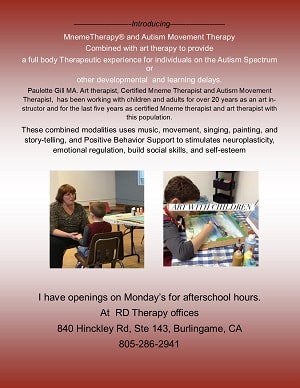
In the realm of therapy, there exists a powerful approach called Mneme Therapy that has shown tremendous promise in working with individuals on the autism spectrum. As an art therapist who has witnessed firsthand the transformative effects of this modality, I am excited to explore and shed light on the unique benefits it offers. In this blog post, we will delve into the essence of Mneme Therapy and its profound impact on individuals with autism, unlocking their creative potential and fostering personal growth.
Understanding Mneme Therapy:
Mneme Therapy is an innovative therapeutic approach that utilizes art, music, and movement to engage individuals with autism. The term "Mneme" comes from the Greek word meaning memory, reflecting the therapy's emphasis on the power of visual memory and its impact on cognition, communication, and emotional well-being.
At its core, Mneme Therapy recognizes that individuals on the autism spectrum often possess exceptional visual thinking and processing skills. Through carefully crafted interventions and activities, Mneme Therapy taps into these strengths, providing a supportive environment for self-expression and promoting social interaction, emotional regulation, and cognitive development.
The Power of Art in Mneme Therapy:
Art serves as a cornerstone of Mneme Therapy, offering individuals with autism a nonverbal channel of communication, self-expression, and connection. Through engaging in art-making activities, such as painting, drawing, sculpting, or collage, individuals on the autism spectrum can express their thoughts, feelings, and unique perspectives in a safe and non-threatening way.
The sensory experience of working with different art materials, exploring textures, and experiencing the visual appeal of colors can also play a vital role in Mneme Therapy. Art activities offer opportunities for sensory integration, allowing individuals with autism to engage their senses and develop a greater understanding of their own sensory preferences and sensitivities.
Promoting Social Interaction and Communication:
One of the significant challenges faced by individuals on the autism spectrum is social interaction and communication. Mneme Therapy provides a platform for cultivating these skills in a supportive and creative environment. Through group art activities or collaborative projects, individuals with autism can develop their abilities to share space, take turns, and engage in cooperative efforts.
Art also acts as a bridge for communication, enabling individuals to express themselves visually and initiate interactions with others. This can lead to increased self-confidence and improved social skills, as individuals find a common ground for connection and understanding.
Cognitive Development and Emotional Well-being:
Mneme Therapy has demonstrated positive impacts on cognitive development among individuals on the autism spectrum. Engaging in art activities can enhance cognitive abilities such as problem-solving, spatial awareness, attention to detail, and visual memory. By stimulating and challenging these cognitive functions, Mneme Therapy supports the holistic development of individuals with autism.
Additionally, the creative process involved in art-making can foster emotional well-being and self-regulation. Art offers a means for individuals to explore and express their emotions, providing a valuable outlet for self-discovery, emotional release, and stress reduction. Mneme Therapy recognizes the therapeutic potential of art in promoting emotional resilience and self-awareness.
Closing Thoughts:
Mneme Therapy stands as a powerful and effective approach in working with individuals on the autism spectrum. Through the medium of art, this therapy unlocks the potential for self-expression, social interaction, cognitive development, and emotional well-being. As an art therapist passionate about serving individuals with autism, I am honored to witness the transformative impact of Mneme Therapy and its ability to empower individuals, nurturing their creativity and supporting their journey towards personal growth and fulfillment.
Understanding Mneme Therapy:
Mneme Therapy is an innovative therapeutic approach that utilizes art, music, and movement to engage individuals with autism. The term "Mneme" comes from the Greek word meaning memory, reflecting the therapy's emphasis on the power of visual memory and its impact on cognition, communication, and emotional well-being.
At its core, Mneme Therapy recognizes that individuals on the autism spectrum often possess exceptional visual thinking and processing skills. Through carefully crafted interventions and activities, Mneme Therapy taps into these strengths, providing a supportive environment for self-expression and promoting social interaction, emotional regulation, and cognitive development.
The Power of Art in Mneme Therapy:
Art serves as a cornerstone of Mneme Therapy, offering individuals with autism a nonverbal channel of communication, self-expression, and connection. Through engaging in art-making activities, such as painting, drawing, sculpting, or collage, individuals on the autism spectrum can express their thoughts, feelings, and unique perspectives in a safe and non-threatening way.
The sensory experience of working with different art materials, exploring textures, and experiencing the visual appeal of colors can also play a vital role in Mneme Therapy. Art activities offer opportunities for sensory integration, allowing individuals with autism to engage their senses and develop a greater understanding of their own sensory preferences and sensitivities.
Promoting Social Interaction and Communication:
One of the significant challenges faced by individuals on the autism spectrum is social interaction and communication. Mneme Therapy provides a platform for cultivating these skills in a supportive and creative environment. Through group art activities or collaborative projects, individuals with autism can develop their abilities to share space, take turns, and engage in cooperative efforts.
Art also acts as a bridge for communication, enabling individuals to express themselves visually and initiate interactions with others. This can lead to increased self-confidence and improved social skills, as individuals find a common ground for connection and understanding.
Cognitive Development and Emotional Well-being:
Mneme Therapy has demonstrated positive impacts on cognitive development among individuals on the autism spectrum. Engaging in art activities can enhance cognitive abilities such as problem-solving, spatial awareness, attention to detail, and visual memory. By stimulating and challenging these cognitive functions, Mneme Therapy supports the holistic development of individuals with autism.
Additionally, the creative process involved in art-making can foster emotional well-being and self-regulation. Art offers a means for individuals to explore and express their emotions, providing a valuable outlet for self-discovery, emotional release, and stress reduction. Mneme Therapy recognizes the therapeutic potential of art in promoting emotional resilience and self-awareness.
Closing Thoughts:
Mneme Therapy stands as a powerful and effective approach in working with individuals on the autism spectrum. Through the medium of art, this therapy unlocks the potential for self-expression, social interaction, cognitive development, and emotional well-being. As an art therapist passionate about serving individuals with autism, I am honored to witness the transformative impact of Mneme Therapy and its ability to empower individuals, nurturing their creativity and supporting their journey towards personal growth and fulfillment.





 RSS Feed
RSS Feed